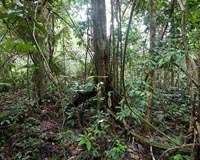| . |  |
. |
Madison WI (SPX) Mar 31, 2010 The number of waste treatment facilities using biological processes to biodegrade waste has been increasing over the years. These installations receive municipal and industrial organic wastes with the common main goal of reducing their biodegradable organic matter content. Composting, anaerobic digestion, and mechanical-biological treatment plants contribute to organic matter recycling and energy recovery, and avoid landfilling. The general goal of those facilities is to stabilize the organic wastes. Stability is defined as the extent to which readily biodegradable organic matter has decomposed. Microorganisms perform the work of decomposition, but what determines when they are finished? A consensus has not yet been reached concerning the most suitable measurement of biodegradable organic matter, or stability, in a solid organic waste. A method for the measure of stability will allow for the proper analysis and design of waste treatment facilities and it is required to evaluate their efficiency. The composting research group at Autonomous University of Barcelona led by Dr. Antoni S�nchez has investigated different methodologies to measure stability focusing on biological indicators, in a study funded by the Spanish Science and Education Ministry and the Catalonia Waste Agency. Authors have presented an improved methodology in the March-April 2010 issue of the Journal of Environmental Quality, which offers a reliable measurement of the biodegradable organic matter content in organic solid materials, useful for researchers and industrial operators. The journal is published by the American Society of Agronomy, Crop Science Society of America, and Soil Science Society of America. This study analyzed samples of food and garden wastes, mixed municipal solid wastes and sludge from wastewater treatment plants. The proposed methodology measures the respiration activity of microorganisms in the waste samples and establishes different respiration indices based on how fast those microorganisms consume oxygen and how much oxygen they have consumed. The authors have established that respiration indices can be used as a measure of the biodegradable organic matter content and stability of organic materials and have defined the most suitable form of expression for those indices. Highly biodegradable wastes will have higher respiration rates, and wastes of low biodegradability will have lower respiration rates. Research is ongoing at the Autonomous University of Barcelona to apply the developed methodology as a diagnostic tool in waste treatment facilities as well as to investigate the effect of stability on greenhouse gas emissions and the overall environmental impact of waste management systems. The authors highlight the need for an agreement of an international standard to be used by researchers and operators in the waste management field.
Share This Article With Planet Earth
Related Links American Society of Agronomy Our Polluted World and Cleaning It Up
 Peruvian Amazon trees a niche market for carbon trading
Peruvian Amazon trees a niche market for carbon tradingSanta Rosa, Peru (AFP) March 30, 2010 In a far-flung corner of the Peruvian Amazon, a multinational company aims to offset carbon dioxide emissions from its factories in France by planting thousands of trees which may also provide an income for local communities. Amid accusations of greenwashing levelled at big firms trying to clean up their image, Nestle Waters France has hired French environmentalist Tristan Lecomte and his ca ... read more |
|
| The content herein, unless otherwise known to be public domain, are Copyright 1995-2010 - SpaceDaily. AFP and UPI Wire Stories are copyright Agence France-Presse and United Press International. ESA Portal Reports are copyright European Space Agency. All NASA sourced material is public domain. Additional copyrights may apply in whole or part to other bona fide parties. Advertising does not imply endorsement,agreement or approval of any opinions, statements or information provided by SpaceDaily on any Web page published or hosted by SpaceDaily. Privacy Statement |